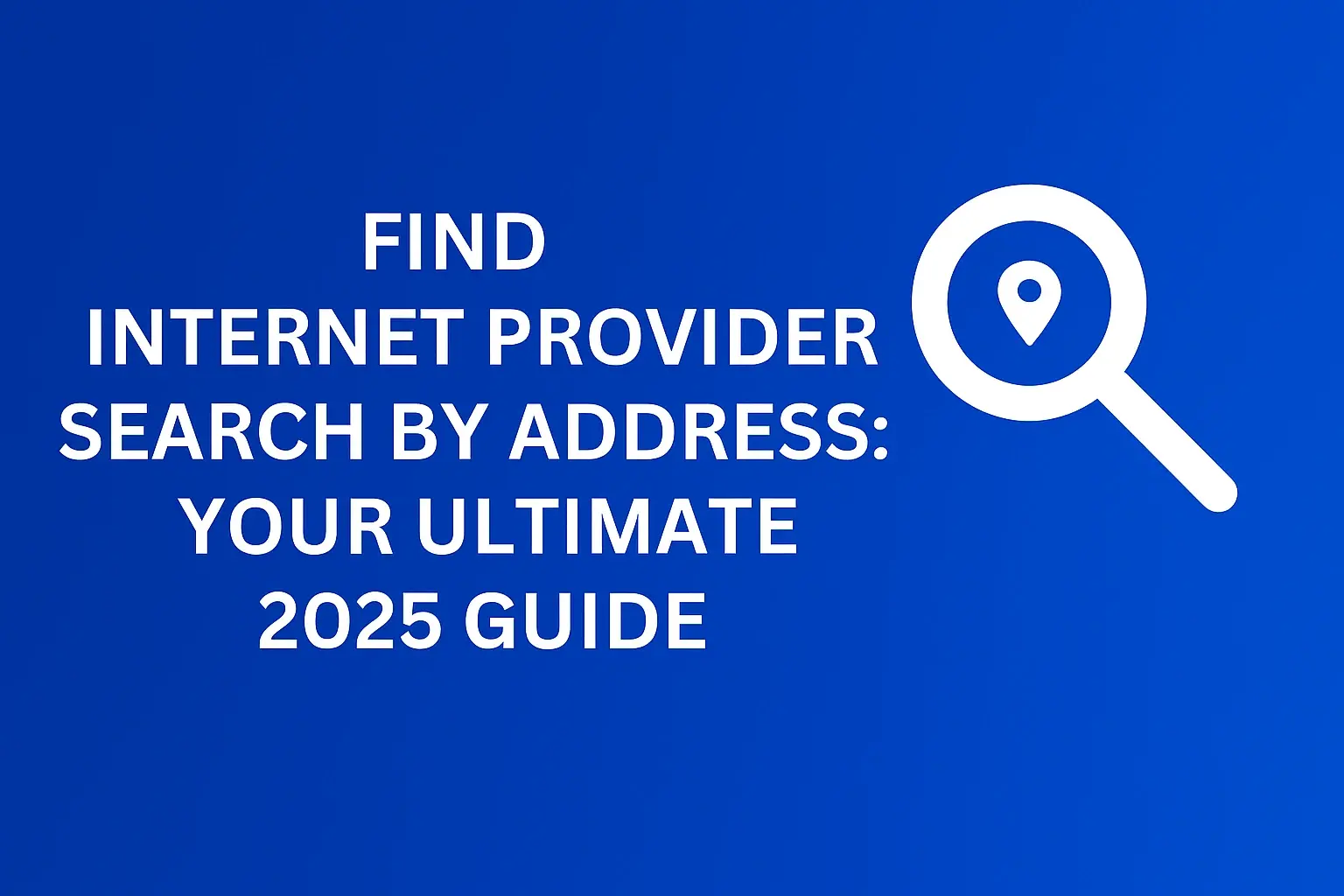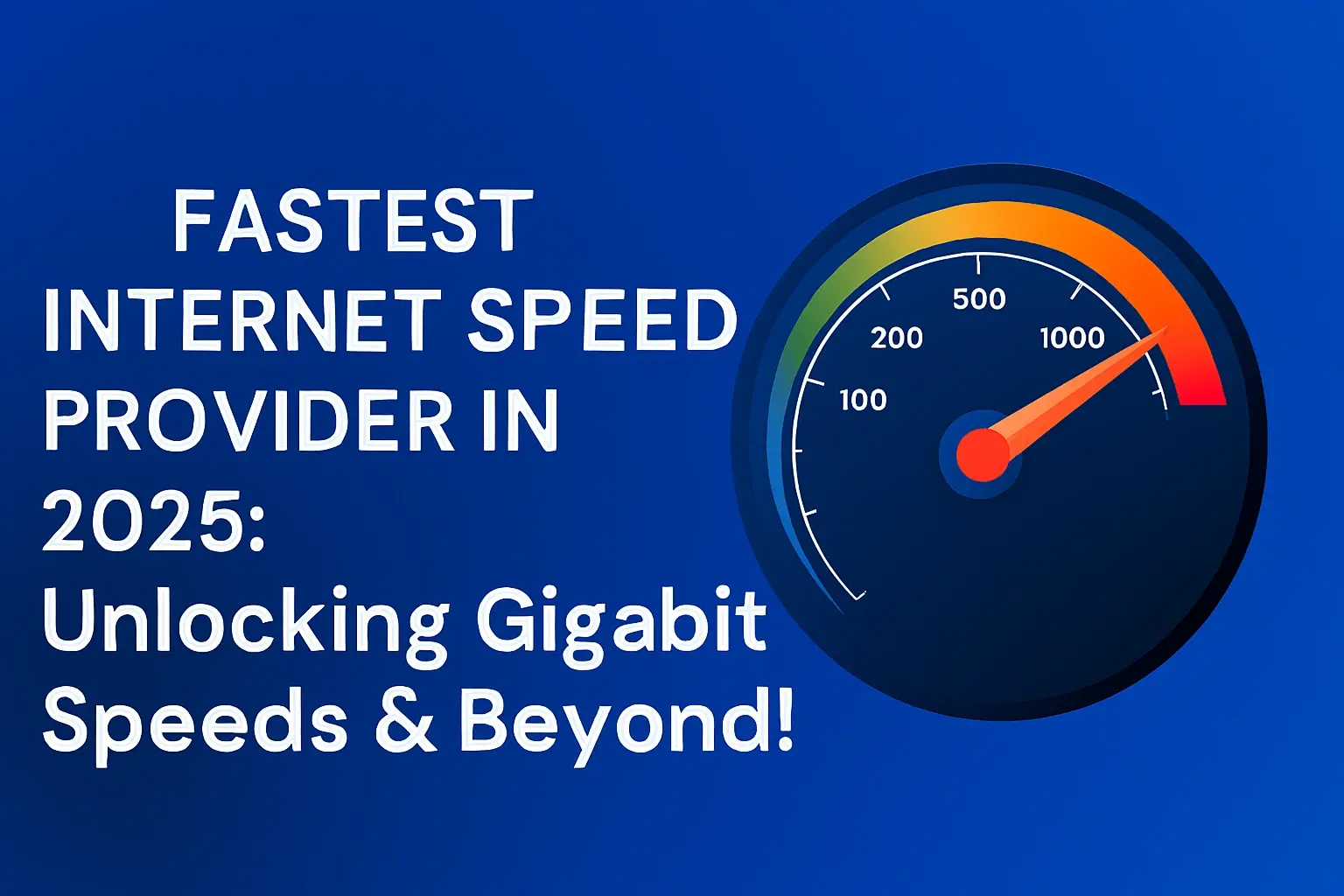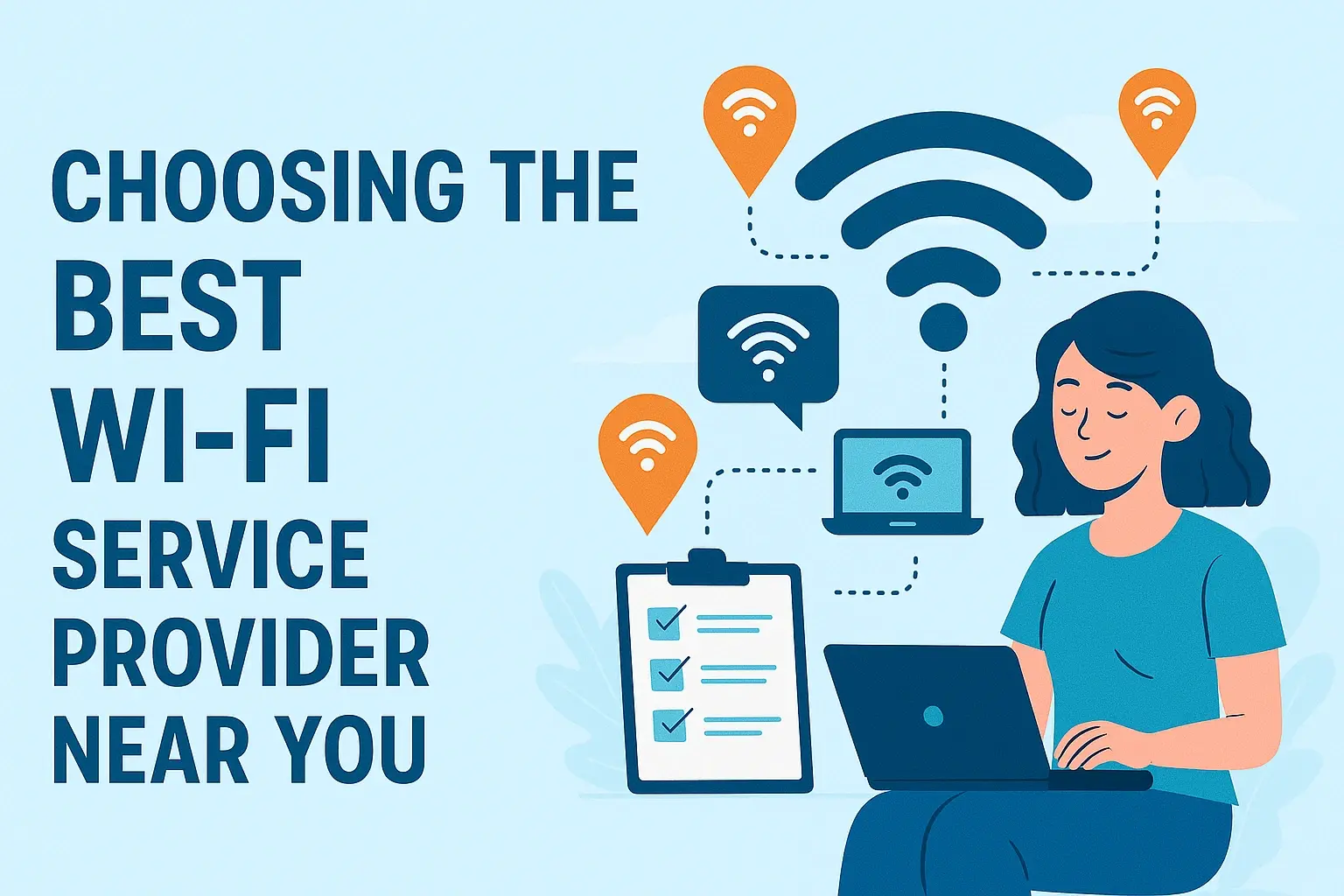Choosing the Best Business Fixed Wireless Internet

Discover how to select the optimal business fixed wireless internet solution. This comprehensive guide navigates the complexities of speeds, reliability, and provider choices, ensuring your business stays connected and competitive in 2025.
What is Fixed Wireless Internet?
Fixed wireless internet, often abbreviated as FWA, is a broadband technology that provides wireless connectivity to a stationary location, such as a business office or home. Unlike mobile wireless, which relies on cellular networks for devices on the go, fixed wireless uses dedicated antennas installed at the business premises to establish a point-to-point or point-to-multipoint connection with a provider's base station. This base station is typically located on a tower or high structure, offering a direct line of sight to the business's antenna. This method bypasses the need for physical cables like fiber optic or copper lines, making it an attractive alternative, especially in areas where traditional wired infrastructure is limited or prohibitively expensive to deploy. The technology leverages radio frequencies to transmit data, offering speeds that can rival traditional broadband options. In 2025, fixed wireless continues to evolve, offering increasingly robust and high-speed internet access for businesses of all sizes.
Key Advantages of Fixed Wireless for Businesses
For businesses operating in today's fast-paced digital landscape, reliable and high-speed internet is not a luxury but a fundamental necessity. Fixed wireless internet offers a compelling suite of advantages that make it a superior choice for many organizations. These benefits range from deployment speed and cost-effectiveness to enhanced reliability and scalability.
Rapid Deployment and Installation
One of the most significant advantages of fixed wireless is its speed of deployment. Traditional wired internet installations, particularly fiber optic, can take weeks or even months to complete. This often involves extensive trenching, laying cables, and navigating complex permitting processes. Fixed wireless, on the other hand, requires the installation of a small antenna on the exterior of the business premises and a corresponding receiver at the provider's tower. This process can typically be completed within days, sometimes even hours, allowing businesses to get online and operational much faster. This is crucial for new businesses launching operations or existing businesses needing to relocate or upgrade their connectivity quickly without significant downtime.
Cost-Effectiveness
The cost savings associated with fixed wireless are substantial. The absence of physical cable installation significantly reduces the upfront costs for both the provider and the customer. Businesses in areas where fiber optic deployment would be prohibitively expensive due to terrain or distance can access high-speed internet at a more affordable rate. Furthermore, ongoing maintenance costs are often lower as there are fewer physical lines to repair or replace due to damage from weather, construction, or wear and tear. In 2025, as competition in the fixed wireless market intensifies, businesses can expect even more competitive pricing structures.
Reliability and Performance
Contrary to some older perceptions, modern fixed wireless technology offers remarkable reliability and performance. Providers utilize advanced spectrum management techniques and robust hardware to ensure consistent connectivity. While a direct line of sight is crucial, many providers employ sophisticated systems to mitigate interference and signal degradation. For businesses that rely on uninterrupted internet for critical operations like cloud-based applications, VoIP services, video conferencing, and e-commerce, the consistent speeds and low latency offered by fixed wireless are invaluable. Many providers also offer Service Level Agreements (SLAs) that guarantee uptime percentages, providing an extra layer of assurance.
Scalability and Flexibility
As businesses grow and their bandwidth needs increase, fixed wireless solutions can often scale more readily than wired alternatives. Upgrading bandwidth typically involves a simple adjustment on the provider's end and potentially a firmware update on the business's equipment, rather than a costly and time-consuming physical infrastructure upgrade. This flexibility allows businesses to adapt their internet services to changing demands without major disruptions. This is particularly beneficial for rapidly expanding companies or those with seasonal fluctuations in internet usage.
Accessibility in Underserved Areas
Fixed wireless is a game-changer for businesses located in rural or geographically challenging areas where traditional broadband infrastructure is scarce or non-existent. It provides a viable path to high-speed internet access, enabling these businesses to compete on a more even playing field with their urban counterparts. This increased accessibility fosters economic development and allows businesses in these regions to leverage digital tools and services that were previously out of reach.
Reduced Vulnerability to Physical Damage
Unlike underground cables that are susceptible to damage from digging, construction, or natural disasters like floods and earthquakes, fixed wireless antennas are typically mounted on elevated structures. While extreme weather can sometimes affect signal strength, the overall vulnerability to physical line breaks is significantly reduced. This enhances business continuity and minimizes the risk of prolonged internet outages.
Potential Disadvantages and How to Mitigate Them
While fixed wireless internet presents numerous advantages, it's essential for businesses to be aware of potential drawbacks and understand how to mitigate them to ensure optimal service. By proactively addressing these concerns, businesses can make informed decisions and maximize the benefits of their chosen internet solution.
Line of Sight Requirements
The most significant technical limitation of fixed wireless is its reliance on a clear line of sight between the business's antenna and the provider's base station. Obstructions such as tall buildings, dense foliage, or significant elevation changes can interfere with or completely block the signal.
- Mitigation: Before committing to a provider, insist on a thorough site survey. A professional survey will assess potential obstructions and confirm if a viable line of sight exists. If direct line of sight is problematic, some providers offer solutions like relay towers or alternative antenna placements.
Weather Interference
Heavy rain, snow, fog, or extreme winds can sometimes impact the signal strength and quality of fixed wireless connections, leading to temporary slowdowns or brief interruptions.
- Mitigation: Modern fixed wireless systems are designed to be resilient to most weather conditions. High-quality equipment and advanced signal processing help minimize these effects. For critical operations, consider a backup internet connection, such as a secondary fixed wireless link from a different provider or a robust 4G/5G mobile hotspot, to ensure continuity during severe weather events.
Limited Bandwidth in Some Cases
While fixed wireless can offer high speeds, the maximum available bandwidth can sometimes be lower than that offered by dedicated fiber optic connections, especially for very large enterprises with exceptionally high bandwidth demands. The shared nature of some fixed wireless deployments means that peak usage times might see a slight degradation in performance if not managed effectively by the provider.
- Mitigation: Clearly define your business's current and projected bandwidth needs. Discuss these requirements with potential providers and review their network architecture. For businesses requiring symmetrical, ultra-high bandwidth consistently, fiber might still be the preferred option. However, for most SMEs, the bandwidth offered by fixed wireless in 2025 is more than sufficient.
Potential for Congestion
In densely populated areas, if a provider's base station serves a large number of users, network congestion can become an issue during peak usage hours. This can lead to slower speeds and increased latency.
- Mitigation: Choose providers known for robust network management and sufficient capacity. Ask about their network architecture and how they manage congestion. Providers that invest in expanding their infrastructure and employ advanced traffic shaping techniques are generally more reliable.
Provider Dependency
As with any single internet service provider, businesses are dependent on the chosen provider for service quality, uptime, and technical support.
- Mitigation: Thoroughly research provider reputations, read customer reviews, and scrutinize their Service Level Agreements (SLAs). Ensure the provider has a strong track record for customer service and technical support. Consider having a secondary backup connection from a different provider for maximum redundancy.
Fixed Wireless vs. Other Business Internet Technologies
Choosing the right internet technology is a critical decision for any business. Fixed wireless internet stands out in a crowded market, offering a unique blend of benefits that often make it superior to traditional options like DSL, cable, and even sometimes fiber, depending on specific business needs and location. Understanding these comparisons is key to making an informed choice.
Fixed Wireless vs. DSL (Digital Subscriber Line)
DSL uses existing copper telephone lines to deliver internet. While widely available, DSL speeds are generally much lower than fixed wireless, especially over longer distances from the telephone exchange. DSL also suffers from symmetrical speed limitations, meaning upload speeds are significantly slower than download speeds.
- Speed: Fixed Wireless typically offers significantly higher download and upload speeds compared to DSL.
- Reliability: Fixed Wireless can be more reliable as it's not constrained by the degradation of old copper lines.
- Deployment: Fixed Wireless deployment is faster.
- Use Case: DSL is suitable for very basic internet needs, while Fixed Wireless is better for businesses requiring moderate to high bandwidth.
Fixed Wireless vs. Cable Internet
Cable internet uses coaxial cables originally laid for cable television. It offers higher speeds than DSL and is more widely available than fiber in many areas. However, cable internet is a shared medium; the bandwidth is distributed among users in a neighborhood. This can lead to significant slowdowns during peak hours when many users are online.
- Speed: Fixed Wireless can offer comparable or superior speeds to cable, especially in terms of upload speeds and consistency.
- Reliability: Fixed Wireless can be more reliable as it avoids the shared bandwidth issues inherent in cable networks.
- Deployment: Fixed Wireless deployment is generally faster than cable installation.
- Use Case: Cable is a good option for many small businesses, but Fixed Wireless offers a more dedicated and potentially faster experience, especially for businesses needing consistent upload speeds for cloud services.
Fixed Wireless vs. Fiber Optic Internet
Fiber optic internet is the gold standard for speed, reliability, and bandwidth. It uses light pulses transmitted through glass fibers, offering incredibly high symmetrical speeds and near-immunity to interference. However, fiber deployment is expensive and time-consuming, often making it unavailable or prohibitively costly in many locations.
| Feature | Fixed Wireless | Fiber Optic |
|---|---|---|
| Speed | High, often symmetrical (up to 1 Gbps+ in 2025) | Extremely High, symmetrical (multi-gigabit speeds common) |
| Reliability | High, but susceptible to line-of-sight and weather | Extremely High, least susceptible to interference |
| Deployment Speed | Fast (days) | Slow (weeks to months) |
| Cost | Moderate to High, often more affordable than fiber in underserved areas | High, especially for new deployments |
| Availability | Growing rapidly, excellent in areas without fiber | Limited by infrastructure, common in urban centers |
| Scalability | Good, easy upgrades | Excellent, virtually unlimited potential |
Use Case: Fiber is ideal for large enterprises with massive bandwidth demands or businesses in areas where it's readily available and affordable. Fixed Wireless is an excellent alternative for businesses that need high speeds and reliability but cannot access fiber, or where fiber deployment costs are prohibitive. For many SMEs in 2025, fixed wireless provides the best balance of performance, cost, and speed of deployment.
Fixed Wireless vs. Satellite Internet
Satellite internet uses a dish to communicate with satellites in orbit. It's often the only option in extremely remote areas. However, satellite internet is known for high latency, lower speeds, and susceptibility to weather, making it unsuitable for most business applications that require real-time responsiveness.
- Speed: Fixed Wireless offers significantly higher speeds and lower latency.
- Reliability: Fixed Wireless is far more reliable and less affected by weather than satellite.
- Latency: Fixed Wireless has much lower latency, critical for VoIP and real-time applications.
- Use Case: Satellite is a last resort for connectivity. Fixed Wireless is a robust business solution.
Crucial Factors When Choosing a Fixed Wireless Provider
Selecting the right fixed wireless internet provider is paramount to ensuring your business receives the speed, reliability, and support it needs to thrive. With numerous providers entering the market, each offering different service tiers and network capabilities, a careful evaluation is essential. Here are the key factors to consider in 2025.
Network Coverage and Availability
The first step is to confirm that the provider actually offers service in your specific business location. Fixed wireless networks are built on a foundation of strategically placed base stations, and coverage can vary significantly even within a few miles.
- Action: Always request a detailed coverage map or, better yet, a site survey to confirm serviceability at your exact address. Don't rely solely on general coverage maps.
Speed and Bandwidth Tiers
Providers offer a range of speed packages, often advertised with maximum download and upload speeds. It's crucial to understand what these speeds mean for your business operations.
- Action: Assess your current and future bandwidth needs. Consider the number of users, types of applications (VoIP, video conferencing, cloud services, large file transfers), and peak usage times. Ask for guaranteed minimum speeds, not just advertised maximums. In 2025, many providers offer symmetrical speeds up to 1 Gbps or more.
Service Level Agreements (SLAs)
SLAs are critical for businesses that cannot afford downtime. They define the guaranteed level of service, including uptime percentages, latency, and response times for technical support.
- Action: Carefully review the SLA. Understand what constitutes an outage, what remedies are offered for breaches (e.g., service credits), and the provider's commitment to maintaining service levels. Look for SLAs that guarantee at least 99.9% uptime.
Customer Service and Technical Support
When issues arise, prompt and effective technical support is vital. A provider's reputation for customer service can make a significant difference in resolving problems quickly.
- Action: Research customer reviews and testimonials. Inquire about their support hours, typical response times, and the expertise of their technical support staff. Do they offer 24/7 support? Is support local or outsourced?
Equipment and Installation
Understand what equipment is provided, whether there are any installation fees, and the typical installation timeline.
- Action: Clarify if the provider supplies the necessary antenna and modem/router, and if there are any associated costs. Ensure the installation process is clearly explained and fits your business schedule.
Pricing and Contract Terms
Beyond the monthly service fee, be aware of any hidden costs, setup fees, early termination fees, or price increases after an introductory period.
- Action: Get a clear, itemized quote. Understand the contract length and any penalties for early termination. Compare the total cost of ownership, not just the monthly price.
Network Technology and Reliability Features
Different providers may use varying fixed wireless technologies. Some may offer more advanced features for reliability and performance.
- Action: Ask about the specific technology they use (e.g., millimeter wave, sub-6 GHz), their network redundancy, and any measures they take to mitigate interference and congestion.
Provider Reputation and Longevity
A provider's history and reputation in the market can be a good indicator of their stability and commitment to service.
- Action: Look for established providers with a proven track record in delivering business-grade internet services.
Decoding Service Level Agreements (SLAs)
For businesses, a Service Level Agreement (SLA) is more than just a contract; it's a guarantee of service quality and a critical component of business continuity planning. When evaluating fixed wireless internet providers, understanding their SLAs is non-negotiable. A well-defined SLA provides peace of mind and recourse should the service fall short of expectations.
Key Components of a Business Fixed Wireless SLA
While SLAs can vary, most comprehensive agreements for business internet services will cover the following critical areas:
Uptime Guarantee
This is the most crucial element. The uptime guarantee specifies the percentage of time the service is expected to be operational. For business-grade services, this should ideally be 99.9% or higher.
- Calculation: A 99.9% uptime guarantee means approximately 8.76 hours of downtime per year. A 99.99% guarantee allows for only about 52 minutes of downtime annually.
- Action: Understand how downtime is measured. Is it measured from the point the business reports an issue, or from when the provider detects it? What constitutes an "outage" versus a "degradation" of service?
Latency Guarantees
Latency, or ping, is the time it takes for data to travel from your business to a server and back. Low latency is essential for real-time applications like VoIP calls, video conferencing, and online gaming.
- Action: Look for SLAs that specify maximum acceptable latency, often measured to a specific point on the provider's network or to a public internet exchange point. For many business applications, latency below 50ms is desirable, and below 20ms is excellent.
Packet Loss Guarantees
Packet loss occurs when data packets fail to reach their destination. This can lead to choppy audio in calls, dropped video streams, and slow file transfers.
- Action: A good SLA will include a guarantee for minimal packet loss, often expressed as a percentage. For business use, packet loss should ideally be below 1%.
Jitter Guarantees
Jitter refers to the variation in the delay of received packets. High jitter can cause issues with real-time applications, particularly voice and video, leading to distorted or broken communication.
- Action: While not always included, a robust SLA might specify maximum jitter levels, crucial for high-quality voice and video performance.
Response and Resolution Times
This part of the SLA outlines how quickly the provider will respond to a reported issue and how long they commit to resolving it.
- Action: Understand the difference between response time (when they acknowledge the issue) and resolution time (when the issue is fixed). Business-grade SLAs often have much faster response and resolution commitments than residential plans.
Remedies for SLA Violations
What happens if the provider fails to meet their SLA commitments? The SLA should clearly state the remedies available to the business.
- Action: Typically, remedies involve service credits—a reduction in your monthly bill. Understand the calculation for these credits and the process for claiming them. Ensure the remedies are meaningful and provide adequate compensation for service disruptions.
What to Watch Out For
Not all SLAs are created equal. Be wary of vague language, exclusions, and overly complex clauses.
- Exclusions: Many SLAs exclude downtime caused by "force majeure" events (acts of God), customer equipment failure, or scheduled maintenance. Understand these exclusions.
- Measurement Points: Where is the service performance measured? It should be measured at the point where the provider's network connects to your premises.
- Complexity: If the SLA is difficult to understand, ask for clarification. A reputable provider will be transparent and willing to explain every detail.
In 2025, as fixed wireless technology matures, providers are increasingly offering robust SLAs that rival those of traditional wired services, making it a viable and reliable option for businesses of all sizes.
The Installation and Setup Process
The installation and setup of fixed wireless internet are generally straightforward and designed to minimize disruption to your business operations. Unlike the extensive civil works required for fiber optic cables, fixed wireless installations are typically quicker and less invasive. Understanding the process can help you prepare and ensure a smooth transition.
Pre-Installation Steps: Site Survey and Planning
Before any physical work begins, the provider will conduct a site survey. This is a critical step to ensure the feasibility of the installation and to determine the optimal placement for equipment.
- Line of Sight Assessment: Technicians will assess the direct line of sight between your business location and the nearest provider base station. They will use specialized equipment to measure signal strength and identify any potential obstructions.
- Equipment Placement: Based on the line of sight assessment, they will determine the best location for the external antenna. This is usually on the roof, side of the building, or a dedicated mast, ensuring an unobstructed path to the base station.
- Interior Equipment Location: They will also identify a suitable location inside your business for the indoor modem or router, considering power availability and proximity to your internal network.
- Scheduling: Once the survey is complete and serviceability is confirmed, a date and time for the installation will be scheduled, ideally at a time that causes minimal disruption to your business.
The Installation Day
The actual installation typically takes a few hours, depending on the complexity of the site.
- External Antenna Installation: Technicians will mount the antenna securely on the exterior of your building. This may involve drilling small holes for mounting brackets. Safety protocols are paramount during this stage.
- Cabling: A cable (usually Ethernet or a specialized RF cable) will be run from the external antenna into your building. The technicians will aim to route this cable discreetly, often through existing conduits or entry points, to minimize aesthetic impact.
- Internal Equipment Setup: The cable will connect to the provider's modem or router inside your premises. This device will then connect to your existing network infrastructure (e.g., your firewall or Wi-Fi router).
- Configuration and Testing: Technicians will configure the equipment, establish the internet connection, and perform speed and connectivity tests to ensure everything is working optimally according to the agreed-upon service plan. They will also verify that the signal strength is robust.
Post-Installation and Go-Live
Once the installation is complete and tested, your business will be connected to the internet.
- Handover and Documentation: The technician will walk you through the setup, explain how the equipment works, and provide any necessary documentation or login credentials.
- Ongoing Support: You will be provided with contact information for technical support should you encounter any issues after the installation.
- Monitoring: Reputable providers will often remotely monitor your connection to proactively identify and address any potential problems.
Tips for a Smooth Installation
- Clear Communication: Ensure you have a point of contact at your business available on installation day to answer any questions the technicians may have.
- Access: Make sure the technicians have unobstructed access to the areas where they need to work, both externally and internally.
- Internal Network Readiness: Ensure your internal network infrastructure (switches, routers, firewalls) is ready to receive the new internet connection.
The efficiency of the fixed wireless installation process is a significant advantage, allowing businesses to benefit from high-speed internet much sooner than with many other technologies.
Understanding Fixed Wireless Pricing and Budgeting
When budgeting for business internet services, understanding the pricing structure of fixed wireless is crucial. While often more cost-effective than fiber optic in certain scenarios, fixed wireless pricing can vary based on speed, bandwidth, contract terms, and provider. By dissecting the components of pricing, businesses can make informed financial decisions and secure the best value.
Components of Fixed Wireless Pricing
Fixed wireless pricing typically comprises several elements:
Monthly Service Fee
This is the core cost and is directly related to the speed and bandwidth package you select. Higher speeds and guaranteed symmetrical bandwidth will naturally command a higher monthly fee. In 2025, business-grade fixed wireless plans can range from around $70-$100 per month for moderate speeds (e.g., 50-100 Mbps) to $200-$500+ per month for gigabit speeds.
Installation and Equipment Fees
While some providers offer free installation and equipment as a promotional incentive, others charge an upfront fee.
- Installation: This covers the cost of the site survey, technician time, and mounting hardware for the external antenna. Fees can range from $0 (promotional) to $500 or more, depending on the complexity.
- Equipment: The provider usually supplies the modem/router and external antenna. Sometimes, this equipment is leased, and a monthly fee is included in the service cost. Other times, it's a one-time purchase or included in the installation fee. Clarify ownership and any associated rental costs.
Contract Length and Early Termination Fees (ETFs)
Fixed wireless contracts typically range from 1 to 3 years. Longer contracts often come with lower monthly rates but higher penalties if you need to break the contract early.
- ETFs: These fees are designed to recoup the provider's investment in installation and equipment if you leave before the contract term is up. They can be a significant cost, so understand the structure (e.g., a flat fee, a prorated amount based on remaining months).
Service Level Agreement (SLA) Costs
While many business plans include a standard SLA, more robust or customized SLAs with guaranteed response times or higher uptime commitments might incur additional costs.
Potential Additional Fees
Be aware of other potential charges, such as:
- Static IP Addresses: If your business requires static IP addresses for servers or specific applications, these often come with an extra monthly fee.
- Data Caps: While less common for business plans, some providers might still impose data caps or throttling after a certain usage threshold. Ensure your plan is truly unlimited if that's a requirement.
- Service Upgrades/Downgrades: Fees may apply if you need to change your service speed mid-contract.
Budgeting Strategies for Businesses
To effectively budget for fixed wireless internet:
- Assess Needs Accurately: Understand your current and future bandwidth requirements. Over-provisioning can lead to unnecessary costs, while under-provisioning can hinder productivity.
- Request Detailed Quotes: Obtain written quotes from multiple providers that clearly itemize all costs, including monthly fees, installation, equipment, and contract terms.
- Negotiate: Don't be afraid to negotiate, especially if you have multiple quotes. Providers may be willing to offer discounts on installation, equipment, or even monthly rates to secure your business.
- Factor in Total Cost of Ownership: Consider the entire duration of the contract and all associated fees, not just the initial monthly price.
- Plan for Contingencies: Budget for potential price increases after promotional periods or for optional add-ons like static IPs.
- Consider Backup Solutions: If uptime is critical, factor in the cost of a secondary backup internet connection.
By thoroughly understanding these pricing elements and employing smart budgeting strategies, businesses can ensure they select a fixed wireless internet solution that meets their technical needs and financial expectations in 2025.
The Future of Fixed Wireless Internet for Businesses
The landscape of business internet connectivity is constantly evolving, and fixed wireless internet (FWI) is at the forefront of this transformation. As we look ahead, FWI is poised for significant growth and innovation, offering even more robust, high-speed, and cost-effective solutions for businesses worldwide. Several key trends and advancements are shaping its future in 2025 and beyond.
Advancements in 5G Technology
The widespread deployment of 5G networks is a major catalyst for the future of fixed wireless. 5G technology offers significantly higher speeds, lower latency, and greater capacity compared to previous generations.
- Higher Speeds: Businesses can expect FWI powered by 5G to deliver multi-gigabit download and upload speeds, rivaling or even surpassing fiber optic capabilities in many scenarios.
- Reduced Latency: The ultra-low latency of 5G will enable more real-time applications, such as augmented reality (AR), virtual reality (VR) for training and collaboration, and advanced IoT solutions.
- Increased Capacity: 5G networks can handle a much larger number of connected devices simultaneously, addressing the growing demand for connectivity in smart offices and industrial environments.
Expansion into mmWave and Sub-6 GHz Spectrum
Providers are increasingly leveraging a wider range of spectrum frequencies for fixed wireless. Millimeter wave (mmWave) spectrum offers extremely high bandwidth and speeds but has a shorter range and is more susceptible to obstructions. Sub-6 GHz spectrum provides a better balance of speed, range, and penetration.
- Hybrid Approaches: The future will likely see providers using a combination of mmWave for dense urban areas requiring ultra-high speeds and sub-6 GHz for broader coverage and more challenging environments. This hybrid approach allows for tailored solutions to meet diverse business needs.
Increased Competition and Market Maturity
As the fixed wireless market matures, competition among providers is intensifying. This competition is driving innovation, leading to better service offerings, more competitive pricing, and improved customer support.
- Service Bundling: Expect providers to offer more bundled services, integrating FWI with cloud solutions, cybersecurity, and managed IT services to provide a more comprehensive connectivity package.
- Focus on Enterprise Solutions: Providers are increasingly tailoring FWI solutions for enterprise-level needs, including robust SLAs, dedicated bandwidth options, and advanced network management tools.
Integration with IoT and Edge Computing
Fixed wireless is becoming an integral part of the Internet of Things (IoT) ecosystem and the rise of edge computing. Its ability to provide high-speed, low-latency connectivity to remote or distributed locations makes it ideal for supporting a vast array of sensors, devices, and localized data processing.
- Smart Cities and Industries: FWI will power smart city initiatives, smart factories, and advanced logistics networks by enabling seamless data flow between devices and edge computing resources.
Addressing the Digital Divide
Fixed wireless technology will continue to play a critical role in bridging the digital divide. Its rapid deployment capabilities make it an efficient solution for bringing high-speed internet to rural, underserved, and hard-to-reach areas where laying fiber is economically unfeasible. This empowers businesses in these regions to participate fully in the digital economy.
Enhanced Reliability and Redundancy
Future FWI solutions will incorporate even more advanced techniques for ensuring reliability, including intelligent beamforming, advanced interference mitigation, and seamless failover capabilities. Businesses will benefit from connectivity that is increasingly resilient to environmental factors and network congestion.
In conclusion, the future of fixed wireless internet for businesses is exceptionally bright. Driven by technological advancements like 5G, expanding spectrum utilization, and increasing market competition, FWI is set to become an even more dominant force in business connectivity, offering unparalleled speed, reliability, and flexibility.
Conclusion
Choosing the best business fixed wireless internet in 2025 hinges on a thorough understanding of your specific needs and a careful evaluation of available providers and technologies. We've explored what fixed wireless is, its significant advantages like rapid deployment and cost-effectiveness, and potential drawbacks such as line-of-sight requirements. By comparing it against other technologies like DSL, cable, and fiber, it's clear that fixed wireless offers a compelling middle ground for many businesses, providing high speeds and reliability without the extensive costs or deployment times of fiber.
When selecting a provider, prioritize network coverage, speed tiers, robust Service Level Agreements (SLAs), and responsive customer support. Deciphering SLAs is crucial for guaranteeing uptime and performance, while understanding the installation process ensures a smooth transition. Budgeting wisely means accounting for all fees and contract terms. The future of fixed wireless, powered by 5G and expanding spectrum use, promises even greater capabilities, making it a forward-thinking investment for businesses. Ultimately, a proactive approach to research and comparison will lead you to the optimal fixed wireless solution that keeps your business connected, productive, and competitive.





